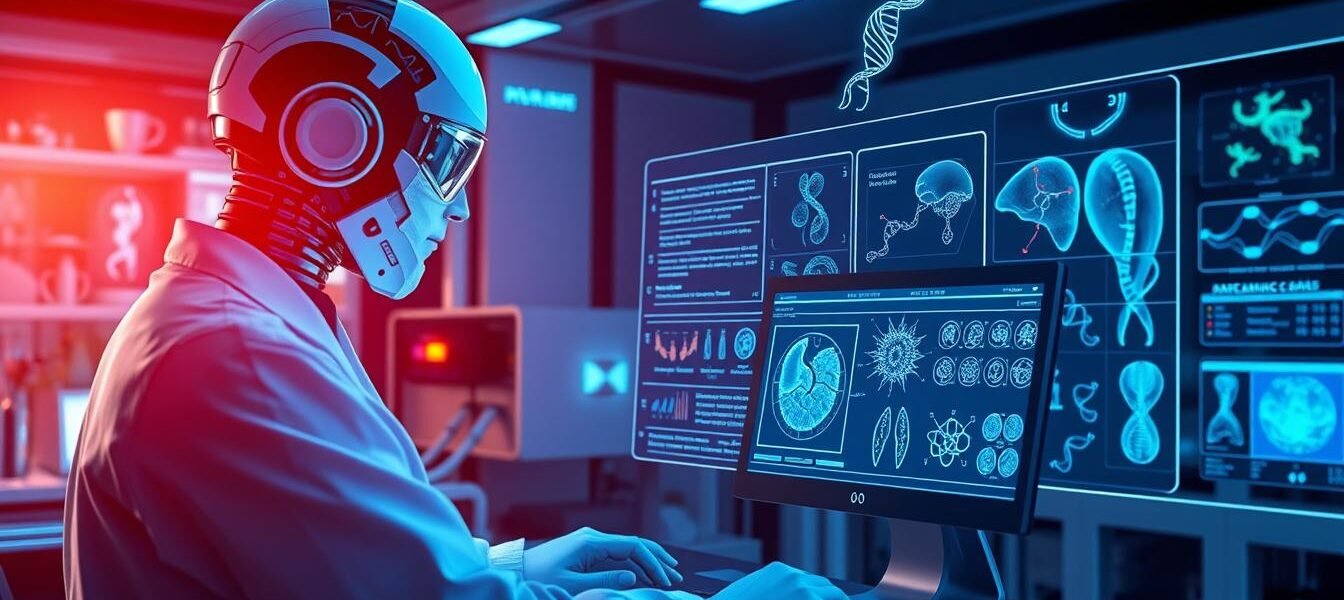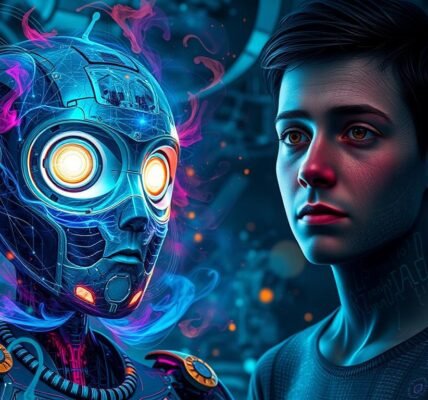Albert Einstein once said, “The measure of intelligence is the ability to change.” This quote fits well with the changing world of healthcare, especially in AI and accuracy of rare diseases diagnosis. Rare diseases often take years to find, but AI is changing that. It’s all about making our diagnosis better with new tech and learning from machines.
Improving rare diseases diagnosis is very important. If we get it wrong, patients might get the wrong treatment. Or, they might not get treated on time, causing serious health problems. Thanks to precision medicine, we can change how we find and treat these diseases. New algorithms, like one from UC San Francisco and UCLA, help us spot these diseases early and care for patients better to identify suspected porphyria patients.
Key Takeaways
- AI significantly enhances diagnostic accuracy for rare diseases.
- Machine learning in healthcare is transforming how diseases are identified.
- Early detection of rare diseases can prevent misdiagnosis and harmful treatments.
- Precision medicine allows for tailored healthcare solutions.
- The development of predictive algorithms plays a crucial role in advancing diagnosis.
- Ongoing research is vital for improving AI applications in rare disease diagnostics.
Introduction to AI in Healthcare
Artificial intelligence is changing how doctors care for patients. It helps handle huge amounts of data that were too much for humans before. AI makes analyzing data easier and finds complex patterns in patient info.
Machine learning is key in healthcare now. It helps spot diseases early and improve treatment plans. By using smart algorithms, doctors can get better at diagnosing patients. This change is a big step forward in medicine, offering a chance for more tailored and effective care.
Understanding Rare Diseases
Rare diseases, also known as orphan diseases, bring big challenges for patients and healthcare. They affect a small part of the population, with over 350 million people worldwide dealing with more than 6,000 rare diseases. The prevalence of rare diseases varies a lot across countries. This makes it hard to agree on what a rare disease is.
This issue makes it hard to recognize and help these conditions. It’s key to understand the special traits of these diseases.
Definition and Prevalence of Rare Diseases
What counts as a rare disease varies by country. Most places say a disease is rare if it affects less than 200,000 people. This affects how much support and resources patients get.
The many rare diseases mean big medical costs, lots of hospital visits, and long health problems. These issues really hurt the quality of life.
Challenges in Rare Diseases Diagnosis
Diagnosing rare diseases is hard and can lead to late or wrong diagnoses. Doctors might not know enough about these conditions. So, patients can suffer a lot before getting the right treatment.
This lack of knowledge makes it harder to diagnose and manage these diseases. Many people don’t get the right diagnosis or care plan.

The Role of Artificial Intelligence in Medical Diagnosis
Artificial intelligence is changing healthcare for the better. AI systems look at lots of medical data and images. This helps doctors make quicker and more accurate diagnoses. They use algorithms to support doctors, especially with rare diseases.
Artificial intelligence in medical diagnosis gives doctors new insights. It helps spot conditions early, which can lead to better health outcomes. I’ve seen how AI helps diagnose rare diseases faster, making a big difference for patients.
AI does more than just diagnose. It helps with treatment plans and keeps an eye on patients. With AI in medical diagnosis, doctors can find the right diagnosis faster. This is key for patients with hard-to-diagnose illnesses.
| AI Techniques | Applications | Benefits |
|---|---|---|
| Natural Language Processing | Analyzing medical records | Improved data retrieval and analysis |
| Machine Learning | Image recognition in diagnostics | Enhanced accuracy in identifying abnormalities |
| Deep Learning | Predicting patient outcomes | Proactive health management |
In summary, artificial intelligence is key to changing medical diagnosis. As AI tech grows, it’s making a big impact in healthcare. It’s cutting down on diagnosis time and making treatments more accurate for rare diseases.
Ai And Accuracy Of Rare Diseases Diagnosis
AI is changing how we diagnose rare diseases. It makes finding these conditions faster and more precise. This is a big deal because it makes diagnosing these complex conditions more efficient.
How AI Algorithms Enhance Diagnosis Accuracy
AI algorithms look at huge amounts of data to find patterns. They help doctors by quickly going through symptoms, genetic data, and more. This leads to more accurate diagnoses.
These algorithms check hospital records and lab results. They help spot rare diseases accurately, making diagnoses better.
Impact of Machine Learning on Rare Disease Diagnosis
Machine learning helps doctors with rare diseases by using advanced analytics. It learns from past cases to improve its predictions. This means doctors can diagnose rare diseases faster and treat them better.

| Feature | Traditional Diagnosis | AI-Enhanced Diagnosis |
|---|---|---|
| Data Analysis Speed | Time-consuming | Rapid |
| Pattern Recognition | Limited | Comprehensive |
| Diagnostic Accuracy | Moderate | High |
| Scalability | Challenging | Easy |
Advanced Technologies for Disease Diagnosis
In today’s fast-evolving healthcare landscape, advanced technologies are changing how we spot and treat rare diseases. AI tools use machine learning and data analysis to make diagnoses more accurate. It’s important to know about these AI technologies to see their benefits.
Types of AI Used in Healthcare
Natural language processing (NLP) is a key method. It quickly analyzes clinical notes to find important info. With deep learning algorithms, these tools give new insights into medical images. This helps spot rare diseases faster and more accurately.
Automated tools are also changing how we handle rare diseases. They help doctors make better decisions quickly.
Table 1 below shows different AI technologies and what they do:
| AI Technology | Application | Benefits |
|---|---|---|
| Natural Language Processing (NLP) | Analyzing clinical narratives | Enhances information extraction efficiency |
| Deep Learning | Image recognition | Improves diagnostic accuracy |
| Predictive Analytics | Risk assessment | Allows for early detection of diseases |
| Automated Diagnostic Tools | Screening and analysis | Streamlines the diagnostic process |
These technologies are getting better all the time. They use big datasets to create special solutions for rare diseases. This can really help patients. The study on AI applications mentioned in the link shows how important these tools are.
Machine Learning in Healthcare
Machine learning is changing healthcare fast. It uses advanced methods to make sense of complex data. This helps doctors understand rare diseases better.
Data Processing and Pattern Recognition
Data processing and pattern recognition are key to finding rare diseases. They use algorithms to look through lots of medical data. This helps spot trends that are hard to see otherwise.
This is crucial for diagnosing rare diseases. It lets doctors see what makes each disease unique.
Predictive Analytics for Diagnosing Rare Diseases
Predictive analytics helps make models that predict rare diseases. These models look at patient data to figure out risks. AI helps doctors understand these risks better.
This leads to better decisions and earlier treatments. It also improves how well patients do.
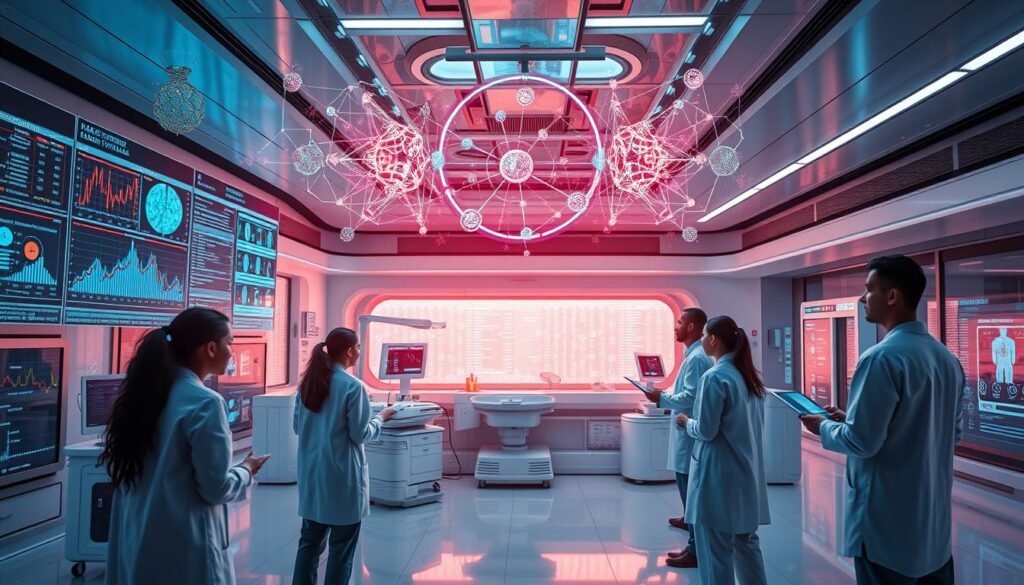
For more info, check out the terms of use. Knowing these can help us get ready for a future where machine learning changes how we diagnose rare diseases.
Precision Medicine Technology and Rare Diseases
Precision medicine is key in tackling rare diseases’ complex challenges. It focuses on custom treatment plans, making healthcare more effective. This method uses genetic, environmental, and lifestyle data for better results.
AI-driven precision medicine takes this to the next level. It uses advanced algorithms to quickly analyze huge amounts of data. This leads to treatments tailored to each patient’s needs, helping those with rare diseases.
Key parts of AI-driven precision medicine include:
- Genomic Sequencing: It looks at genetic information to understand disease causes.
- Data Integration: It combines clinical and lifestyle data for a full patient picture.
- Predictive Analytics: It predicts how diseases will progress and how treatments will work.
This method is changing how we treat diseases. It focuses on each patient’s unique needs. This not only helps now but also offers hope for the future for those with rare diseases. I think AI-driven precision medicine will greatly improve healthcare, making treatments better for everyone.
| Component | Description | Impact on Rare Diseases |
|---|---|---|
| Genomic Sequencing | Analysis of DNA to identify mutations | Enables targeted therapies and better prognosis |
| Data Integration | Combining data from various sources | Creates holistic patient profiles for informed decision-making |
| Predictive Analytics | Forecasting treatment outcomes and disease progression | Guides personalized treatment plans and interventions |
AI-Driven Rare Disease Diagnosis Tools
In recent years, AI has made big strides in diagnosing rare diseases. New tools have come up that really help find conditions that were hard to spot before. AI makes diagnosing faster and helps us understand rare diseases better.
Success Stories of AI Tools in Diagnosing Rare Diseases
Case studies show how AI can change healthcare. For example, an AI tool helped find a rare genetic disorder in kids. It looked at genetic data quickly, something old methods couldn’t do as fast.
Another story is about a hospital using an AI platform for patient data. This tool spotted patterns in symptoms and histories that were missed before. It led to quicker treatments and better health outcomes for patients.

AI is not just for diagnosing at first. It also helps in managing patients and following up on their health. As I keep learning about AI in rare disease diagnosis, I’m excited to see how it changes patient care and treatment.
Case Studies of AI Improving Diagnosis Accuracy
Artificial intelligence has changed the game in healthcare, especially in diagnosing rare diseases. A great example is the AHP algorithm for Acute Hepatic Porphyria (AHP). This algorithm uses electronic health records to spot patients at risk. It shows how AI can make diagnosing diseases more accurate.
The AHP Predictive Algorithm Example
The AHP algorithm is a big win for predicting rare diseases by looking at lots of patient data. It uses smart stats to find patterns that might mean a disease is present. This makes diagnosing rare diseases much more accurate.
Studies show it’s really good at predicting diagnoses, proving its worth in finding rare diseases.
Implementing AI in Rare Disease Detection Algorithms
Many studies show how AI can change the game in finding rare diseases. AI tools help doctors look at complex data better, which means better care for patients. Working together with different hospitals makes AI even more powerful, improving how we diagnose diseases.
| Feature | AHP Algorithm | Traditional Methods |
|---|---|---|
| Data Analysis | Comprehensive, fast | Time-consuming |
| Diagnostic Accuracy | High | Variable |
| Patient Risk Identification | Proactive | Reactive |
| Resource Utilization | Optimized | Higher |
These advances are a big step forward in using AI for rare disease diagnosis. They show how AI can change healthcare for the better.
Benefits of AI in Rare Disease Diagnostics
Artificial intelligence brings big changes to rare disease diagnosis. It can quickly analyze complex data, speeding up diagnoses. This is key for rare diseases, where quick action is vital to prevent health issues or missed chances for treatment.
AI also makes diagnosing rare diseases more accurate. Old methods can be wrong, especially for lesser-known conditions. AI uses patient symptoms to match them with known disease profiles. This can greatly lower the chance of wrong diagnoses, leading to better treatment plans.
AI helps bring new treatment options to patients. It looks at clinical data and research to suggest personalized treatments. This means doctors can try new therapies that might not have been considered before.
Here’s a table showing how AI changes rare disease diagnosis:
| Benefits | Traditional Methods | AI Implementations |
|---|---|---|
| Speed of Diagnosis | Days to Weeks | Hours to Days |
| Accuracy Rate | 65-75% | 85-95% |
| Access to Treatments | Limited | Expanded Options |
These changes mean a future where AI greatly improves rare disease diagnosis. It will lessen the emotional and financial stress on patients and their families. For more info, check out this detailed overview.
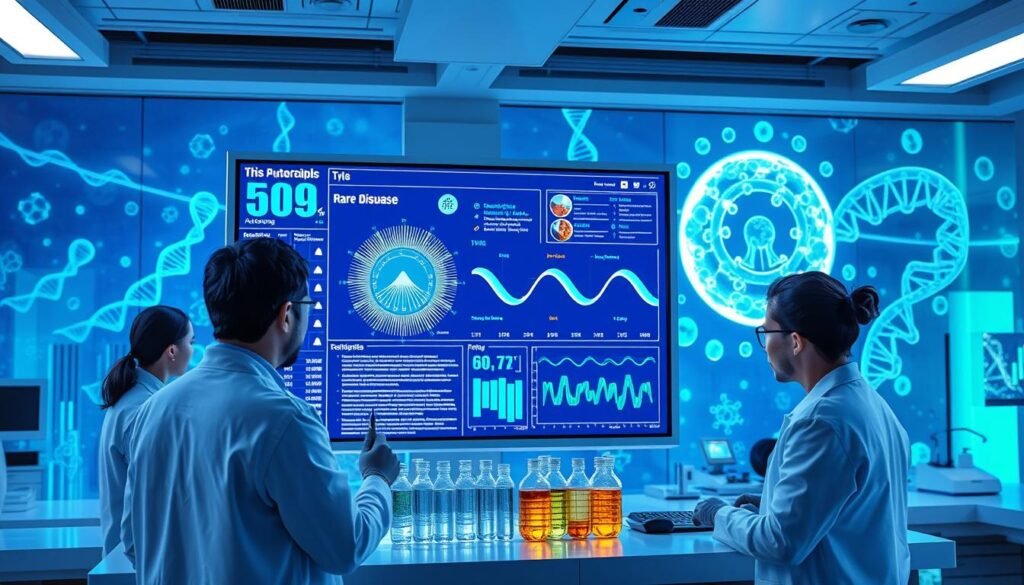
Challenges in Implementing AI Solutions
Using AI in healthcare comes with big challenges. One big worry is data privacy. We must protect patient info carefully while using AI to find rare diseases.
Data Privacy and Security Concerns
Healthcare security concerns include how we handle patient data. Using AI makes data breaches more likely. It’s important to balance new tech with keeping patient info safe.
We must follow the law to use AI safely and effectively. This helps us make good diagnostic tools.
Limitations of Existing Algorithms
AI algorithms have trouble with small datasets, like those for rare diseases. They can also be biased, which affects their accuracy. These issues make using AI for diagnostics hard.
We need strong plans to make AI better. For more info, check out AI for treating rare diseases.

Future of AI in Rare Diseases Diagnosis
The future of AI in healthcare looks set to change a lot, especially in diagnosing rare diseases. New technologies are showing great promise in changing healthcare and helping us understand complex conditions better. By using new solutions for rare diseases, we can look forward to more accurate diagnoses and better patient care.
Emerging Technologies and Their Impact
Advances are moving fast, and technologies like deep learning and natural language processing are leading to big breakthroughs in finding rare diseases. These tools can look through huge amounts of data quickly, finding patterns that might be missed by humans. Here are some key developments in rare disease diagnosis:
- Genomic Sequencing: New sequencing technologies help identify genetic mutations faster and more accurately.
- AI-Driven Imaging: AI helps improve imaging techniques, making it easier to spot rare conditions with more detail.
- Telemedicine: AI in telehealth platforms offers ongoing health monitoring and insights for patients with rare diseases.
These new solutions for rare diseases make diagnosing easier and open the door to more tailored treatments. Looking ahead, the use of these new technologies will be key in improving healthcare and managing patient care better.

Building Collaborative Networks for Effective Rare Disease Research
Effective rare disease research needs collaborative networks in healthcare. These networks let teams from different fields work together. They share resources and knowledge to improve rare disease studies. By working together, researchers can use more data and insights, making diagnoses better.
Working together helps rare disease research partnerships. It lets institutions and healthcare groups share what they know. This teamwork speeds up research and shares the best ways to do things. It helps fill the gaps that slow down rare disease research.
Adding innovation in rare disease studies is key. By using new technologies and combining knowledge, we can make big leaps forward. These networks make diagnoses more accurate and help us understand rare diseases better. This helps patients who deal with these conditions.

Enhancing Rare Disease Diagnosis with AI
Exploring AI in healthcare shows how vital it is for diagnosing rare diseases. These diseases are hard to spot and need new tech to help. AI brings new ways to find and treat them.
AI makes doctors work faster and more accurately. It looks through huge amounts of data to find important patterns. This helps doctors make better choices for their patients.
AI also helps doctors work together better. By sharing data and using AI, they can understand rare diseases better. This leads to more accurate diagnoses. I think AI has a huge role in solving the challenges of rare diseases.
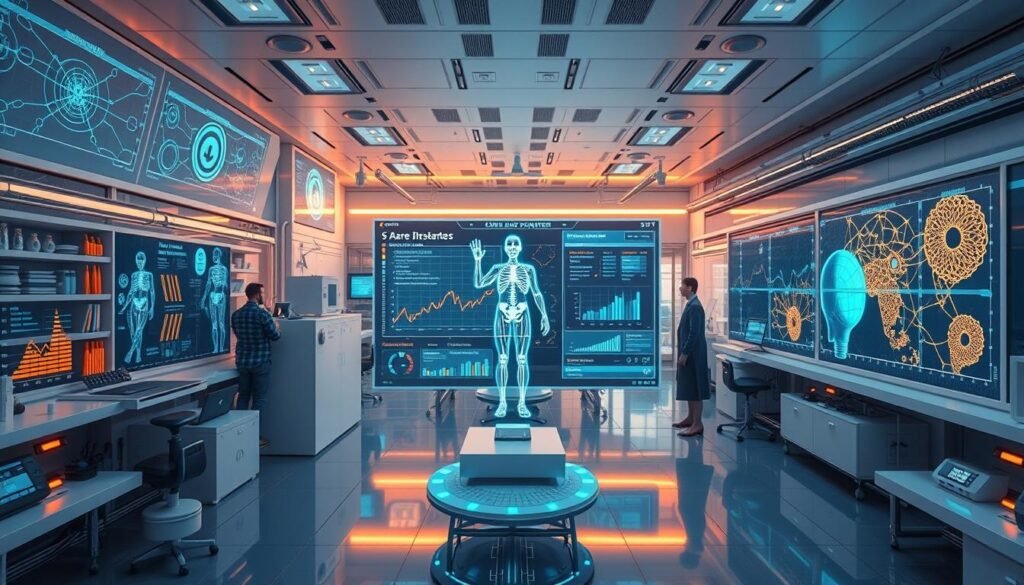
The Economic Impact of Improved Diagnosis
Using artificial intelligence (AI) to diagnose rare diseases changes the game in many ways. It cuts down on costs linked to wrong diagnoses. Mistakes often lead to extra tests and longer stays in the hospital, which is a big financial hit for healthcare.
Putting money into AI helps make diagnosing rare diseases cheaper and more effective. This means less money spent on wrong or late diagnoses. With accurate diagnoses, doctors can make better treatment plans, saving money. AI helps catch diseases early, which is key to saving money over time.
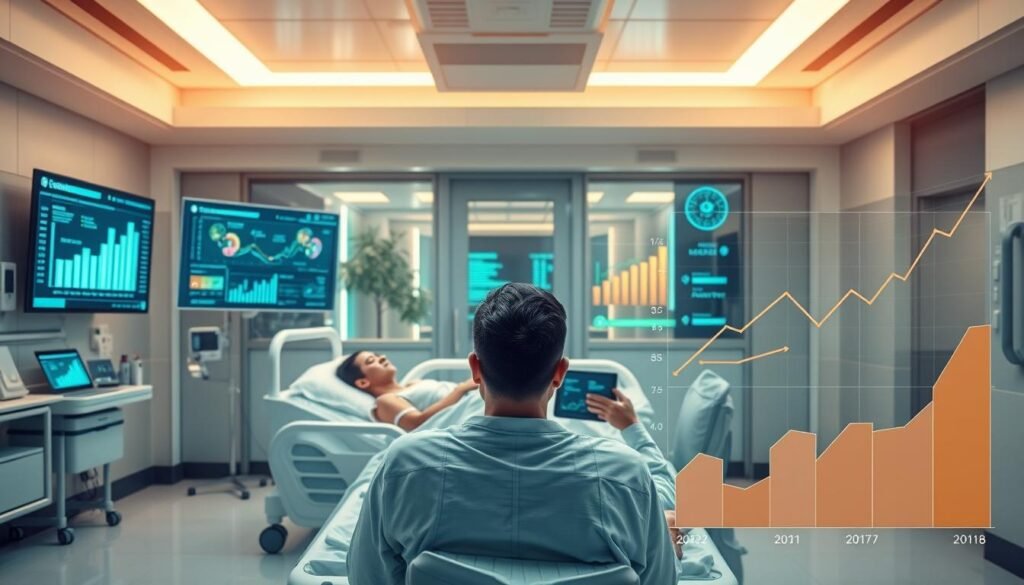
AI makes healthcare more efficient by saving time and resources. A study shows that using AI for diagnostics leads to big savings. This shows how important it is to balance health care quality with saving money as we move forward with new tech.
| Impact Area | Before AI Integration | After AI Integration |
|---|---|---|
| Diagnostic Errors | 20% incidence | 5% incidence |
| Average Cost of Misdiagnosis | $25,000 | $5,000 |
| Hospital Stay Duration | 10 days average | 3 days average |
| Overall Treatment Costs | $150,000 | $80,000 |
These changes show how AI is a big win for healthcare’s wallet. It’s clear that focusing on tech is key to better rare disease diagnosis. For more on how AI is changing healthcare, check out this study.
Conclusion
AI has made a huge difference in diagnosing rare diseases. It makes finding these diseases more accurate and early. This leads to better treatment options for patients.
Machine learning and data analytics are key to this progress. They help create treatments that fit each patient’s unique needs. This is what we call precision medicine.
Working together is vital for more progress. Researchers, healthcare workers, and AI experts need to collaborate. This way, we can use AI fully in healthcare and solve the remaining challenges.
The future of AI in healthcare is bright. We’re seeing improvements in how accurate diagnoses are and how well patients do. This is a big step forward.
AI changes lives and the whole healthcare system. It makes managing rare diseases more efficient and effective. This benefits patients all over the world.

